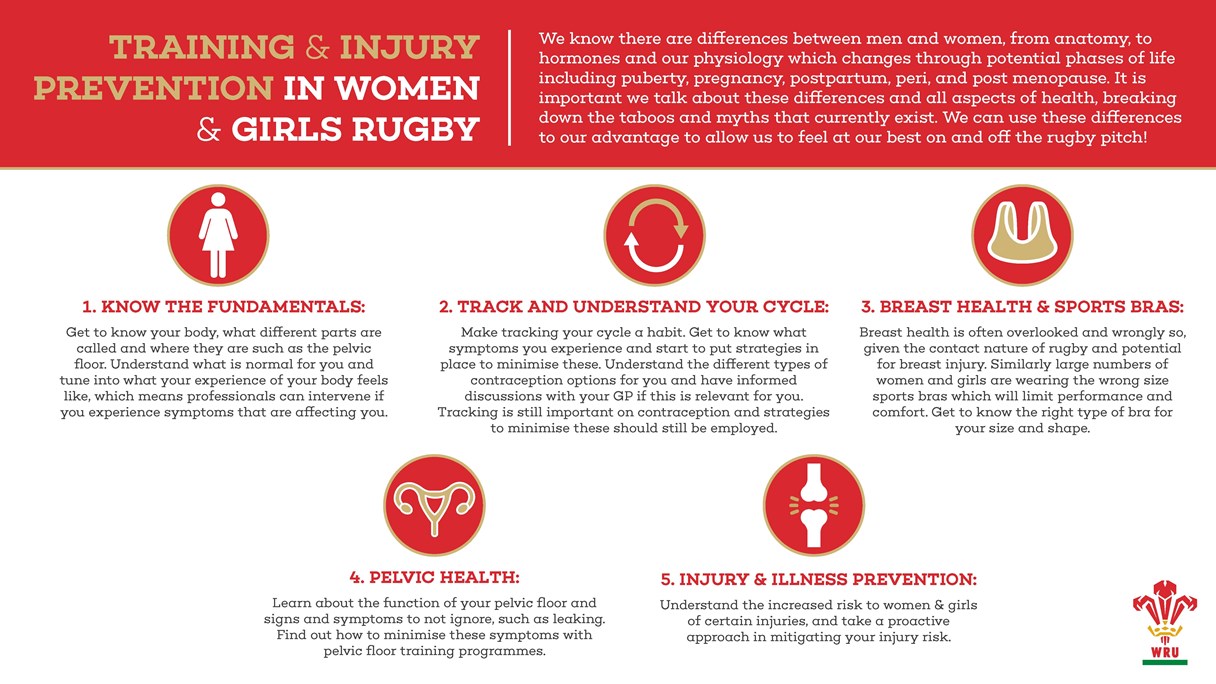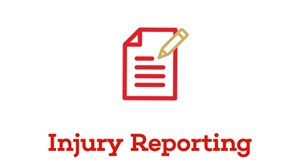

WOMENS AND GIRLS SPECIFIC INJURY PREVENTION
Research has demonstrated that women and girls are more at risk of certain type of injuries. Anterior cruciate ligament (ACL) injuries particularly receive a lot of focus, unsurprisingly so given that they often lead to a lengthy time away from rugby. Females are also more at risk of breast injuries, stress urinary incontinence as well as other gynaecological conditions. Research has also shown females may experience prolonged recovery from concussion.
Women and girls are also 2 x more likely to suffer a concussion than men and often have more severe symptoms with longer recovery times. The exact reasons for this are still being researched but could be due to females having lighter heads and weaker necks, with poorer falling/landing techniques resulting in whiplash type events on the pitch.
- Lighter heads
- Weaker necks
- Thinner brain cells
- Menstrual cycle hormones
- Poor movement control and falling technique
Risk Factors for lower limb injuries
Risk factors for injury are often multifactorial and can be modifiable (things we can’t change such as our anatomy) and modifiable (meaning we can take measures to change them). The good news is that the majority of risk factors for ACL injuries are modifiable. It is important to understand why ACL injury rates may be higher for females to then embark upon prevention strategies to help minimise the risk and keep you on the pitch!!
Anatomy- Females have a greater Q angle compare with males (the angle between the hip and knee) which increases the angular stress on the knee joint. This is often referred to a a ‘valgus’ position which is seen during cutting and landing, and is a risky position for injury
Strength: Quads:Hamstring ratio- Females have stronger quads compared with male counterparts
Skill error/landing and cutting technique- hip dropping, pore core control and knee falling in
Age- the greatest age risk is 15-25 years. Implementing prevention programmes at an early age results in fewer ACL injuries. Additionally females tend to have less of a training history
Hormones- there is a small amount of evidence to show that ACL injury is a higher risk during ovulation. However it is important to remember that not everyone gets injured around ovulation. Some females ask about taking the oral contraceptive pill to mitigate this risk, which has proven ineffective. If we maximise strength, stability and coordination this small risk can be mitigated. Other females find specific trends throughout their cycle such as low back pain during the pre menstrual phase or hamstring tightness at other stages. Therefore it is vital to track your cycle to identify these patterns and put strategies in place such as extra mobility and strength exercises during these times to mitigate ht risk.
REDS- Relative energy deficiency is a condition caused very broadly by underrating or overturning, or most commonly a combination of the two. If our menstrual cycle hormones change, (particularly less oestrogen which is important in bone strength and remodelling), then they can become more prone to injuries such as stress reaction dns tress fractures. Oestrogen is lso vital for immune functioning so a reduction can increase risk of illness.
Footwear: The majority of footwear has been designed and tailored to men. Broadly speaking women have narrower heels, higher arches and wider balls of feet and therefore the same footwear may not fit appropriately. There is not definitive research around footwear and injury risk but what is advised that women try numerous boots that result in a good fit and are uncomfortable.
Surface: The literature around surface and injury risk is also mixed. Not everyone injures on the same surface so again it is important that the correct footwear is worn taking into account the weather and surface
ANTERIOR CRUCTIATE LIGAMENT INJURIES
Statistics
Female athletes are 6-8 times more likely to rupture their ACL compared with males
80 % of ACL injuries are typically from non-contact events and 20% re-injure within two years
- The greatest age risk is 15-25 years. Those with less training history may also be at a higher risk.
- Injuries usually occur with a sudden forced deceleration or change of direction
Injury prevention strategies
The good news is that many injuries can be prevented with strength and conditioning progammes. World Rugby's ACTIVATE programme has been shown to reduce ACL risk. Incorporating injury prevention exercises into warm ups or training sessions for 10 minutes, 3 times per week, can reduce injury risk in girls by 30%.
All programmes should include:
Plyometrics
Neuromuscular training
Strength training for key muscle groups (quadriceps, hamstrings, gluteals)- give examples qith videos and pictures
Encouraging balanced muscle development to avoid quadricep dominance
Landing mechanics
Improve core strength and stability
Improve movement skills like agility and coordination
Correct poor landing and movement mechanics- understand poor technique
Click HERE to access the full guidance document
Click HERE for a copy of the infographic
This resource has been tagged...


